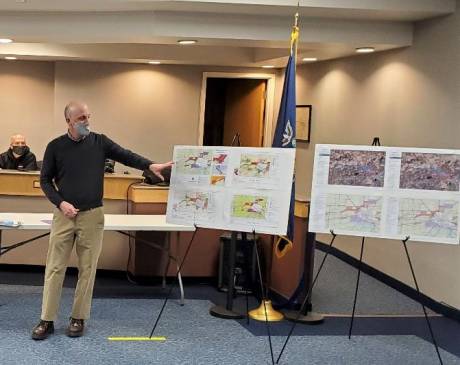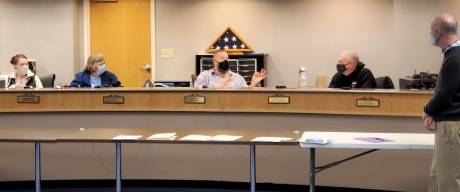
Members of a committee charged with updating the Town of Batavia’s solar law on Wednesday night acknowledged that a compromise on setback distance requirements may be in order after hearing from two couples seeking to place ground-mounted systems on their property.
Speaking at an informational meeting at the Town Hall on West Main Street Road, Dan Reuter, a Corfu resident, said he has issues over the 200-foot setback criteria listed in the final draft of the town’s Solar Energy Local Law.
Reuter and his wife, Kathy, own 68 acres on Alexander Road (Route 98) in the Town of Batavia.
“The setbacks proposal is extremely constraining,” Reuter said, adding that such a condition would put an end to his plan to place a 1.8-megawatt solar array on 9 acres of his property. “It will make it not viable.”
As currently written, the final draft stipulates that Tier 3 systems shall meet the following requirements:
- Be setback from any non-participating property line by 200 feet;
- Be setback from any participating property line by 20 feet;
- Be setback from any adjoining, participating property existing structure by 30 feet;
- Be setback from any adjoining, non-participating structure by 500 feet.
Reuter said his property is vacant and, for the most part, unusable, farm land that already is limited in scope due to requirements of the New York State Department of Environmental Conservation. He said that he is looking to put in the solar system to assist in the couple’s retirement.
“We ask that you would revisit that,” he said, noting that 200 feet “would kill us” but that a 50-foot setback would work.
John and Kerry Hylkema said they applied in 2016 for a permit to place solar on their property on Alexander Road.
“We saw other solar farms go in,” Kerry said. “and we’ve been waiting and waiting.”
Her husband said he also disagreed with the setback requirements, and asked for the committee’s “consideration to work with us.”
Buffalo attorney Charles Malcomb, representing solar developer Renewable Properties on behalf of the Reuters and Hylkemas, referred to a letter that he wrote to the committee highlighting other projects where the setback was less than 200 feet.
“The main issue is the setback from non-participating properties,” he said. “Two hundred feet is a real problem.”
Malcomb pointed to projects in the towns of Alabama and Sardinia where a 50-foot setback was in place.
“We think that’s a sufficient setback,” he said, noting that screening provisions would help to “hide” the panels – one of the goals of the solar law.
At that point, Dan Lang, who also is the town’s building inspector, asked other committee members to weigh in on the 200-foot setback. He then proposed keeping the 200-foot limit on the front and changing it to 50 feet on the side and rear.
“The intent is to get these away from roads and houses,” he said.
Committee member Nancy Brach, a town resident, asked Malcomb to modify his renderings to show various distances, and he agreed that he would fulfill that request.
The committee has been working on a new solar law – one that would mesh with the town’s Comprehensive Plan – for about a year.
Drew Reilly (photo above) of Wendel Companies of Williamsville is the group’s consultant and he spoke at length last night about the progress it has made.
Reilly said that the solar environment is changing rapidly.
“If you have a solar law and it’s more than three years old, it’s probably outdated,” he said. “NYSERDA (New York State Energy Research and Development Authority) is even updating its law” (because it doesn’t address everything).
Lang said the committee will take another look at topics brought up last night (others included the percentage of Smart Growth land to be used for solar and the role of planning boards and zoning boards of appeals in the process) and submit the revised law to the Batavia Town Board sometime next month.
Town Supervisor Gregory Post, who was in attendance, said he hopes to have the law passed by April. Before that can happen, the law needs to go through a State Environmental Quality Review, review by the Genesee County Planning Board and Town Planning Board, and a public hearing.

Photo: Town of Batavia solar committee members, from left, Brittany Witkop, Nancy Brach, Dan Lang, Paul McCullough. Reilly is at right. Photos by Mike Pettinella.
Previously: Town of Batavia committee drafts revised solar energy law, sets informational meeting for Dec. 29
